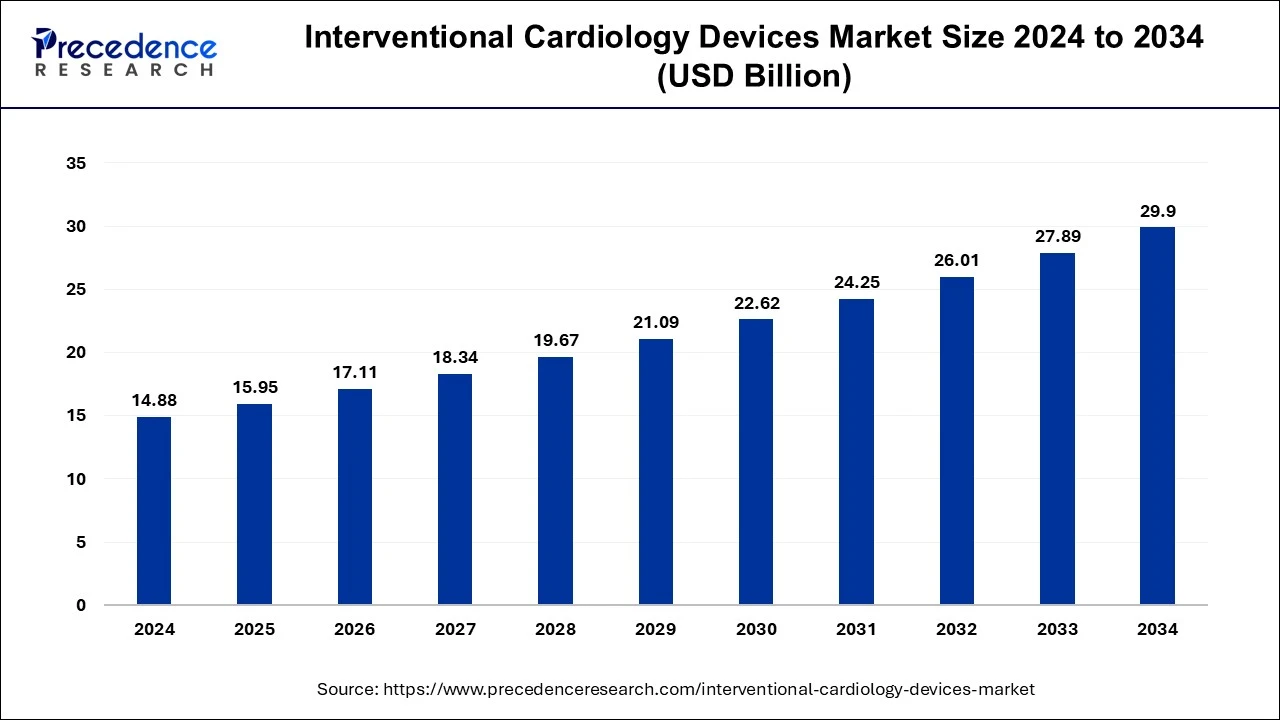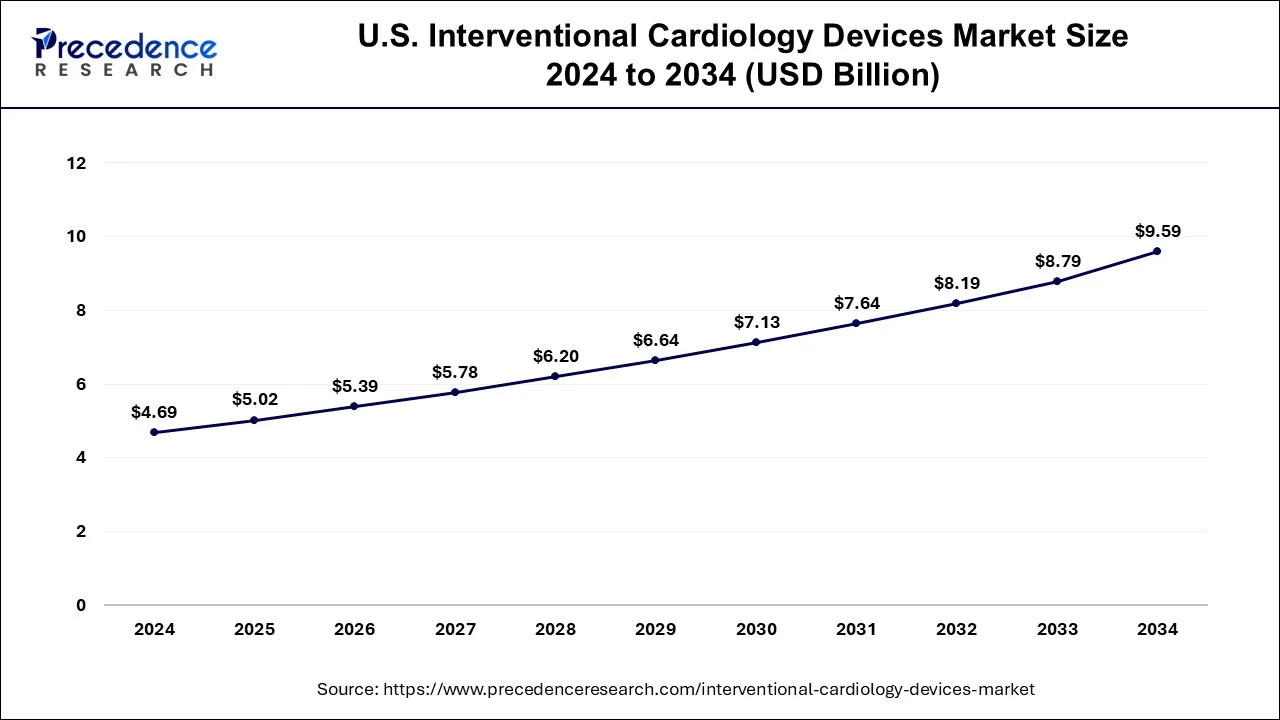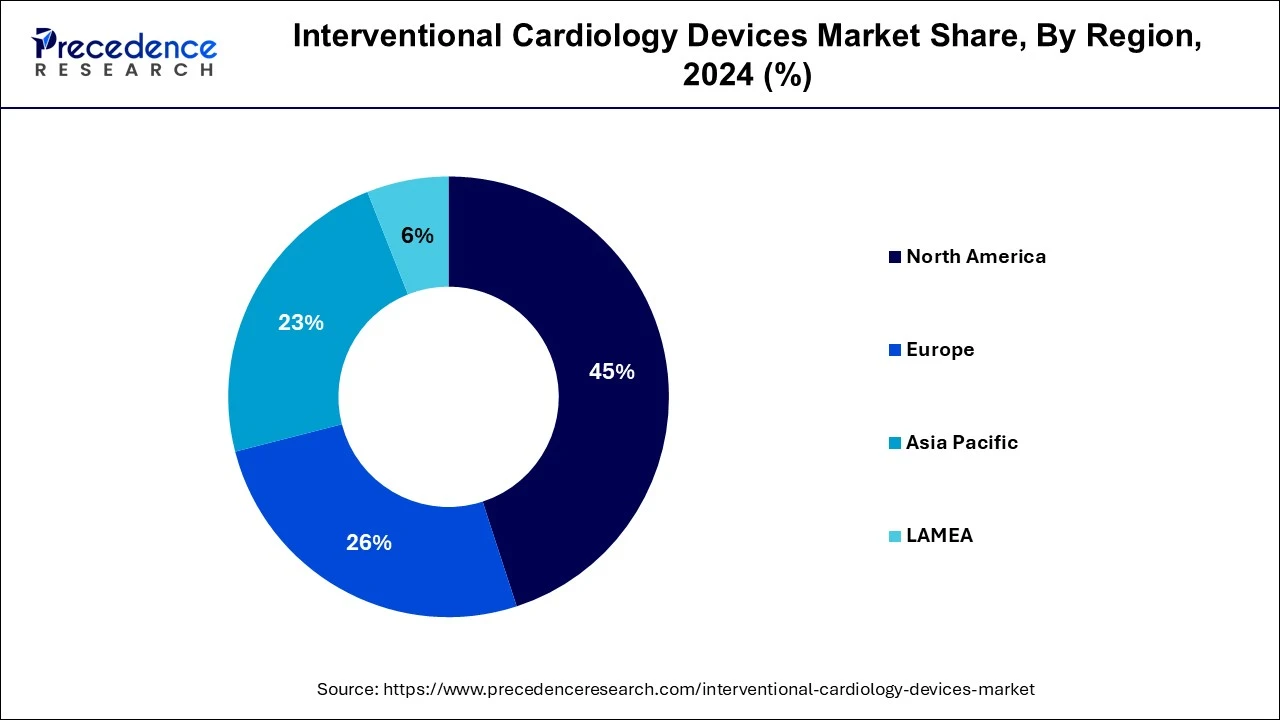April 2024
The global interventional cardiology devices market size is calculated at USD 15.95 billion in 2025 and is forecasted to reach around USD 29.9 billion by 2034, accelerating at a CAGR of 7.24% from 2025 to 2034. The North America interventional cardiology devices market size surpassed USD 6.70 billion in 2024 and is expanding at a CAGR of 7.34% during the forecast period. The market sizing and forecasts are revenue-based (USD Million/Billion), with 2024 as the base year.
The global interventional cardiology devices market size was estimated at USD 14.88 billion in 2024 and is anticipated to reach around USD 29.9 billion by 2034, expanding at a CAGR of 7.24% from 2025 to 2034.

The advancements in AI technology has drastically the changed the overall healthcare sector. AI has been integrated in most of the medical fields for enhancing medical procedures and lowering the mistakes of healthcare professionals. Nowadays, the cardiology devices manufacturers have started adopting AI in their factories for enhancing the manufacturing process. AI can help in interventional cardiology by analyzing angiography images for transcatheter aortic valve implantation and valve placement. Moreover, AI helps in detecting the presence of heart diseases along with providing suitable methodologies for getting cured.
The U.S. interventional cardiology devices market size was evaluated at USD 4.69 billion in 2024 and is predicted to be worth around USD 9.59 billion by 2034, rising at a CAGR of 7.41% from 2025 to 2034.

North America dominated the global market with the largest market share of 45% in 2024. The presence of advanced healthcare infrastructure, favorable government product development initiatives, and high patient awareness levels, combined with relatively high healthcare expenses in the region, are some of the major drivers for the interventional cardiology devices market to grow. In North America, the U.S. is a major contributor of the market with presence of several market players such as Boston Scientific, Abbott Laboratories, Cardinal Health and some others. These market players are adopting several strategies such as product launches, acquisitions, partnerships and some others to maintain their dominance in the industry.

Europe is expected to grow with the highest CAGR during the forecast period. Europe has a high rate of premium-priced interventional cardiology devices consumption, and it is the region that can accommodate a high rate of medical device innovation, thereby dominating the interventional cardiology devices market. Also, the cases of peripheral artery disease has increased rapidly in Germany and France that in turn increases the demand for cardiology devices, thereby boosting the market growth. Moreover, several government initiatives aimed at advancing the cardiology department along with technological advancement in healthcare sector has boosted the growth of the interventional cardiology devices market in this region.
Interventional cardiology is a subspecialty of cardiology. Interventional cardiologists are cardiovascular diseases specialists who have completed training. They focus on the use of catheters, which are thin, flexible tubes used to execute procedures. Angioplasty and stenting, for example, are accomplished by directing equipment through the body’s arteries. These minimally invasive interventional techniques are an excellent alternative to open surgery for many individuals.
Interventional cardiology is concerned with the use of catheters to treat heart problems. The process entails inserting a device such as balloon, stent, catheter, or other device into femoral artery or any other big peripheral artery or vein, and then cannulating the heart under X-ray guidance. Furthermore, a variety of interventional cardiology devices are utilized to treat peripheral vascular problems that impact the circulatory system and can lead to plaque build-up in limb arteries. The catheters, balloons, stents, and filters are some of the interventional cardiology devices on the market.
| Report Coverage | Details |
| Market Size in 2024 | USD 14.88 Billion |
| Market Size in 2025 | USD 15.95 Billion |
| Market Size in 2034 | USD 29.90 Billion |
| Growth Rate From 2025 to 2034 | 7.24% |
| Largest Market | North America |
| Base Year | 2024 |
| Forecast Period | 2025 to 2034 |
| Segments Covered | Product and Region |
| Regions Covered | North America, Europe, Asia-Pacific, Latin America, and Middle East & Africa |
Rising Incidences of Ischemic Heart Disease
The prevalence of ischemic heart disease has grown significantly in several countries such as the U.S., India, China and some others. It is usually caused by joining of fatty material and plaque inside the coronary arteries through a process called atherosclerosis. These diseases are caused by several factors such as smoking tobacco, obesity, high cholesterol, old-age, diabetes and some others. The interventional devices including angioplasty balloons, angioplasty stents, angioplasty catheters are found effective for treating this heart disease. Thus, the growing prevalence of coronary artery disease (CAD) has increased the demand for interventional cardiology devices, thereby boosting the industrial expansion.
According to American College of Cardiology, in 2023, ischemic heart disease was the leading cause of death with an age-standardized rate per 100,000 of 108.8 deaths.
Presence of Alternatives
The interventional cardiology devices industry experiences several problems. Firstly, there are several alternative techniques such as lipid-lowering drugs and anticoagulants that are highly effective for treating heart diseases, that in turn hampers the industry. Secondly, various market players have recalled their products due to their negative impact in the human body, thereby restraining the growth of the interventional cardiology devices market.
Adoption of Biosensors in Cardiology
The application of biosensors has increased rapidly in the cardiology sector. In cardiology, these sensors are used for detecting cardiac biomarkers and measuring blood pressure. It also finds application in clinical analysis and diagnosis of several cardiac disorders. Also, the wearable biosensors are used for continuously monitor vital signs such as heart rate and pulse. Moreover, these sensors are capable of measuring pulse wave velocity for detecting the stiffness of arterial walls. Thus, the growing use of biosensors in cardiology is anticipated to create growth opportunities in the upcoming days.
The coronary stents segment held the largest share of the market. The rising demand for preventing heart attacks and strokes has driven the market growth. Also, these stents helps in curing problems such as chest pain and shortness of breath that is crucial for the industrial expansion. Moreover, the capacity of stents to improve blood flow and reduce the risk of re-narrowing along with the rapid adoption of minimally invasive surgical procedures has boosted the market growth.
The intravascular imaging catheters and pressure guidewires segment is projected to witness the fastest CAGR during the forecast period. The growing demand for intravascular imaging catheters for diagnosing and treating heart conditions by delivering cross-sectional images of the heart and blood vessels has boosted the market growth. Also, the rising application of pressure guidewires in measuring blood pressure gradient and calculating fractional flow reserve (FFR) is driving the industrial expansion. Moreover, the rise in number of patients suffering from epicardial disease and coronary microvascular dysfunction has increased the demand for these devices, thereby driving the growth of the interventional cardiology devices market.
The market is moderately fragmented with the presence of several local companies. These market players are striving to gain higher market share by adopting different marketing strategies, such as new product launch, investments, partnerships, and mergers & acquisitions. The companies are also spending on the development of improved products. Moreover, they are also focusing on competitive pricing.
The various developmental strategies such as acquisition, business expansion, investments, new product launches, partnerships,joint venture, and mergers fosters market growth and offers lucrative growth opportunities to the market players.
By Product
By Geography
For inquiries regarding discounts, bulk purchases, or customization requests, please contact us at sales@precedenceresearch.com
No cookie-cutter, only authentic analysis – take the 1st step to become a Precedence Research client
April 2024
June 2024
July 2024
April 2025